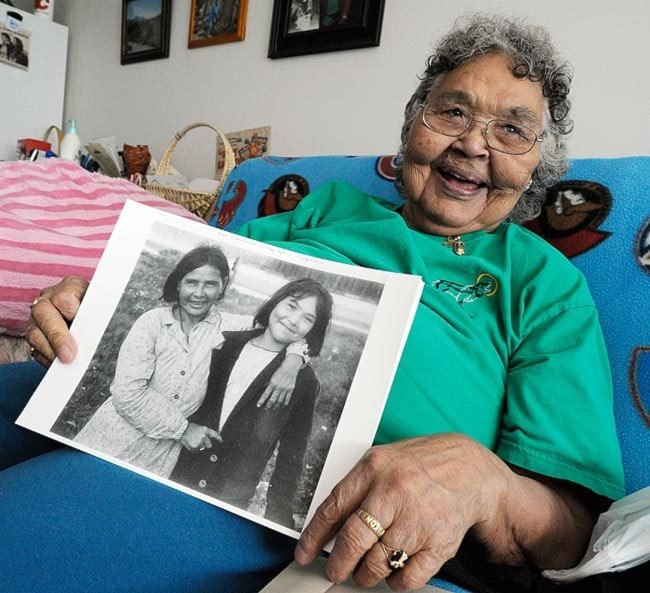Angela Carlick was about 14 years old when an American family simply appeared out of the bush one day.
“I didn’t know there was anybody around us,” said Carlick, now 83. “I thought it was only us living in and around Lower Post. There was no one there, just that river that was a highway.”
The American family was led by William Hamilton Albee, who was instrumental in building the Alaska Highway.
At that time, in the early 1940s, US Army engineers, who had begun building the future highway, referred to it as “Route C.”
The National Geographic Society offered Albee the opportunity to explore the area by foot, before the strip of tarmac changed it forever.
He and his outdoorsy wife Ruth decided they would take their eight-year-old son Billy and five-year-old daughter Jo-Evelyn along.
The family flew into Watson Lake and trekked, on foot, to Frances Lake, living almost completely off the land.
Along the way, they came across Liard Tom and his family.
“These guys walked through these native trails right to my dad’s house,” said Carlick, sitting in her apartment in Whitehorse. “They just came across and my dad led them and showed them where to go.”
This adventurous family was not the only group Liard Tom gave directions to in those days.
Tom was instrumental in the building of the Alaska Highway, guiding the US Army through the bush and along trails and trap lines, said Carlick.
In February, Carlick sent a letter to Jim Robb, a local artist and historian who writes the Colourful Five Per Cent column for the News.
In her letter, she noted her hope to have her father recognized for his help in building the highway.
“You should say something when someone does something nice for you. You should spread it around,” she said. “They needed help and my father was there to help them.”
Robb is fascinated by Yukon history and when the letter came his interests were piqued, he said.
“This was an interesting story and I thought the letter from Angela was an excellent letter with so much detail about our recent history,” said Robb. “I don’t think the First Nations have ever been recognized for their work on the highway.”
The walls of Carlick’s apartment are covered in photographs, including one the Albees took of her parents.
The photo was included in a National Geographic article that was published in May, 1942.
The article is almost a journal, written by William and his wife Ruth.
Halfway through, it talks about their encounter with the Tom family.
They came across Liard, his wife Ada and two of their children, Fanny and Frank, as they were waking up at a camp on their trapline.
They asked Tom about trails to Frances Lake.
After telling them there were no trails, Tom eyed Ruth’s backpack.
“He picked it up and grunted, “Much too heavy, too heavy for man,’” says the article.
That’s when Tom and his wife shook their heads, saying “My, oh my,” as the family continued on their way, according to the article.
Later on, the two families came across each other again.
The Albees made camp while the Toms carried on, Liard boasting about his ability to cover great distances without rest, says the article.
However, in the morning, the Albees came across the Tom’s deserted camp only a mile farther, says the article. They also came across the markings the Toms left, directing the family to their home.
It was after reading Carlick’s description of the article in her letter that Jack Whitehouse, a Han First Nation man from Dawson City, contacted his old-time friend Robb.
“It struck me that I had that article and thought it really belongs with the old girl,” Whitehouse said of Carlick. “It’d make her happy.”
Whitehouse and Robb joined forces, getting pictures of the Tom family from the article blown up and printed to give to Carlick, along with the magazine.
They gave it to her on Thursday.
The final picture included in the article is of Carlick and her mother.
“That’s me,” she exclaimed when she saw the copy Robb and Whitehouse handed her.
She remembers them taking that photo, she said.
“We didn’t know what was going on,” she said. “They spoke to my dad, not to us.”
There are other photos of Carlick’s history on the land all over her apartment like pictures of her stretching hides and hunting moose.
She still hunts, fishes and lives in the bush for most of the summer.
It is the way she prefers to live, she said.
Talking again about her father and the help he gave to the Hudson’s Bay Company, as well as the army, Carlick stressed the importance of the knowledge people like her father possessed.
“They are special people, those who know the land,” she said. “Especially those trappers. They know the land real well.”
The Transportation Museum is considering recognizing Liard Tom and others who helped with the highway, said Robb.
The museum could not be reached by press time.
Contact Roxanne Stasyszyn at
roxannes@yukon-news.com
